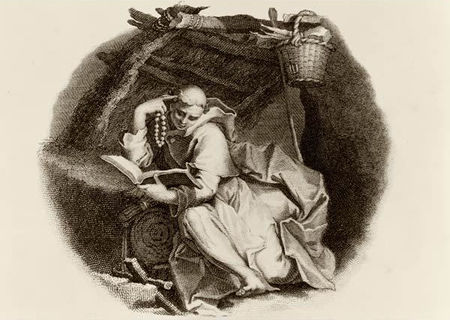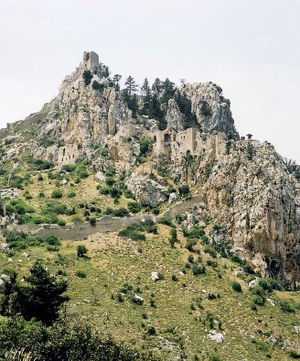Saint Hilarion

Following his life as Saint Paul, the Ascended Master Hilarion fulfilled his final incarnation as Saint Hilarion, who was born near modern-day Gaza over two hundred years after Paul's death.
Early life
Hilarion, like Paul, was a convert to Christianity. When he was just fifteen, he gave up youthful pleasures to devote his days to prayer and fasting in a tiny hut in the wilderness.
Butler’s Lives of the Saints tells of the humility and devotion of the saint:
Being desirous to begin to serve God in perfect solitude,... he gave part of his goods to his brethren and the rest to the poor, reserving nothing for himself.... He retired into the desert.... He was a comely and even delicate youth, affected by the least excess of heat or cold, yet his clothing consisted only of a sackcloth shirt, a leather tunic which St. Antony gave him, and an ordinary short cloak....
For years together his food was fifteen figs a day, which he never took till sunset. When he felt any temptation of the flesh he would say to his body, “I will see to it, thou ass, that thou shalt not kick,” and then cut off part of his scanty meal....
During the first years he had no other shelter than a little arbour, which he made of woven reeds and rushes. Afterwards he built himself a cell ... four feet broad and five in height, and a little longer than his body, like a tomb rather than a house. Soon he found that figs alone were insufficient to support life properly and permitted himself to eat as well vegetables, bread and oil. But advancing age was not allowed to lessen his austerities.
St. Hilarion underwent many grievous trials. Sometimes his soul was covered with a dark cloud and his heart was dry and oppressed with bitter anguish; but the deafer Heaven seemed to his cries on such occasions, the more earnestly he persevered in prayer.[1]
Miracles and healings
Hilarion spent twenty years in the desert in preparation for his mission and only then wrought his first miracle—God working through him, he cured a woman of barrenness enabling her to bring forth a son. From that day forward, he carried out a healing ministry.
He healed children of a fever by invoking the name of Jesus, cured paralysis and cast out many devils. Crowds would gather to be healed of diseases and unclean spirits. They followed him even into the most desolate and remote places. He tried many times to hide, but they always found him, compelling him to follow his true calling, for the love of Jesus.
Once, he sailed away and hid in Sicily, but a devil cried out through a man in St. Peter’s Church in Rome, “Hilarion the servant of Christ is hiding in Sicily. I will go and betray him.” Still possessed of the demon, he set sail for Sicily and went directly to Hilarion; throwing himself down in front of his hut, he was cured. The saint couldn’t hide from the people and he couldn’t hide from the devils! As Jerome said of him, “A city set on an hill cannot be hid.” Hilarion had become that city by his devotion to Christ, and by that devotion, he magnified the Lord.
Jerome, whose biography of the saint provides most of the information we know about him, records:
The frequency of his signs in Sicily drew to him sick people and religious men in multitudes; and one of the chief men was cured of dropsy the same day that he came, and offered Hilarion boundless gifts; but he obeyed the Saviour’s saying, “Freely ye have received; freely give.”[2]
And then the Lord did something truly extraordinary through him. On the occasion of a great earthquake, when the sea was threatening to destroy the town, Hilarion turned back a tidal wave. According to Jerome,
The sea broke its bounds; and, as if God was threatening another flood, or all was returning to primeval chaos, ships were carried up steep rocks and hung there.

The townsfolk, seeing these mountains of water coming towards the shore, ran and got Hilarion and,
as if they were leading him out to battle, stationed him on the shore. And when he had marked three signs of the cross upon the sand, and stretched out his hands against the waves, it is past belief to what a height the sea swelled, and stood up before him, and then, raging long, as if indignant at the barrier, fell back, little by little, into itself.
Toward the end of his life, the people’s saint, for they had claimed him as their own, retreated to a spot in Cyprus so remote that he was convinced no one would find him there. It was even haunted—the people would be afraid to approach, he thought. But one who was paralyzed managed to drag himself there, found Hilarion, was cured and spread the word.
And so it was that the saint ended his days in that remote place, with many people coming to see him. After his passing, his followers buried him there, as was his desire, but within several months his closest disciple, Hesychius, secretly dug up his grave and carried his body off to Palestine.
The ascended master Hilarion has shared with us a revelation he received in this last physical incarnation on earth as the great healer and hermit:
I AM Hilarion! I have walked in the desert places! I have taken my refuge in the desert of life, but the multitudes came after me into the desert as I lived in my final incarnation as Hilarion. They came for the healing fountain; they came for love. Though I would retreat, they would follow. And so the Lord told me that the gift of Truth and of healing is only for the sharing, only for the giving away.[3]
Ascension
At the conclusion of his embodiment as the great healing saint, Hilarion, following in the footsteps of his Lord, ascended in the ritual that Jesus had demonstrated. He is now known as the ascended master Hilarion, ever accessible to his many disciples around the world.
See also
Sources
Mark L. Prophet and Elizabeth Clare Prophet, Lost Teachings on Keys to Spiritual Progress, p. 63.
Elizabeth Clare Prophet, Hilarion the Healer: The Apostle Paul Reborn, pp. 42–48.
- ↑ Herbert Thurston and Donald Atwater, eds., Butler’s Lives of the Saints, rev. (New York: P. J. Kenedy and Sons, 1962), 4:163.
- ↑ Matt. 10:8.
- ↑ Hilarion, “The Personal Saviour, The Personal Guru,” Mark L. Prophet and Elizabeth Clare Prophet, Lords of the Seven Rays, book 2, p. 181.
